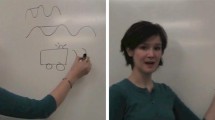Abstract
The Scientists-in-Action series is a multimedia environment for anchoring science instruction in meaningful contexts. Video anchors are designed according to research-based design principles and used in classroom contexts with adolescents. In two experiments, students who worked with an episode about a chemical spill showed gains in content knowledge and more positive attitudes toward science and scientists than did students who did not see the episode.
Access this chapter
Tax calculation will be finalised at checkout
Purchases are for personal use only
Preview
Unable to display preview. Download preview PDF.
Similar content being viewed by others
References
Bransford, J.D., Sherwood, R., Vye, N., Rieser, J. (1986). Teaching thinking and problem solving: research fondations. American Psychologist, 41, 1078–1089.
Bransford, J. D., Vye, N., Kinzer, C., Risko, V. (1990). Teaching thinking and content knowledge: Toward an integrated approach. In B. F. Jones, L. Idol (eds.), Dimensions of thinking and cognitive instruction: Implications for educational reform, 381–413. Hillsdale, NJ: Lawrence Erlbaum Associates.
Cognition and Technology Group at Vanderbilt. (1990). Anchored instruction and its relationship to situated cognition. Educational Researcher, 19(6), 2–10.
Cognition and Technology Group at Vanderbilt. (1992). The Jasper experiment: An exploration of issues in learning and instructional design. In M. Hannafin, S. Hooper (eds.), Educational Technology Research and Development, 40, 65–80.
Cognition and Technology Group at Vanderbilt. (1993). Toward integrated curricula: Possibilities from anchored instruction. In M. Rabinowitz (ed.), Cognitive science foundations of instruction, 33–56. Hillsdale, NJ: Lawrence Erlbaum Associates.
Dewey, S. (1933). How we think: Restatement of the relation of reflective thinking to the educative process. Boston: Heath.
Gragg, C. I. (1940, October 19). Because wisdom can’t be told. Harvard Alumni Bulletin, 78–84.
Hanson, N. R. (1970). A picture theory of theory meaning. In R. G. Colodny (ed.), The nature and function of scientific theories, 233–274. Pittsburgh: University of Pittsburgh Press.
Schwab, J. J. (1960). What do scientists do? Behavioral Science, 5, 1–27.
Author information
Authors and Affiliations
Editor information
Editors and Affiliations
Rights and permissions
Copyright information
© 1994 Springer-Verlag Berlin Heidelberg
About this paper
Cite this paper
Goldman, S.R. et al. (1994). Multimedia Environments for Enhancing Science Instruction. In: Vosniadou, S., De Corte, E., Mandl, H. (eds) Technology-Based Learning Environments. NATO ASI Series, vol 137. Springer, Berlin, Heidelberg. https://doi.org/10.1007/978-3-642-79149-9_12
Download citation
DOI: https://doi.org/10.1007/978-3-642-79149-9_12
Publisher Name: Springer, Berlin, Heidelberg
Print ISBN: 978-3-642-79151-2
Online ISBN: 978-3-642-79149-9
eBook Packages: Springer Book Archive




